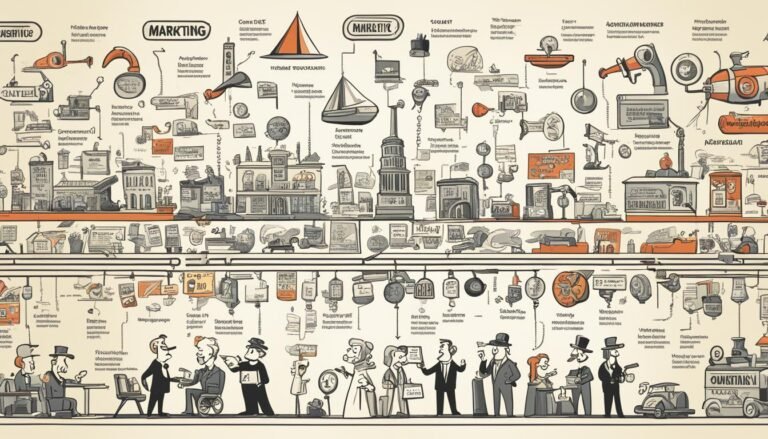The Attention Economy: Capturing and Retaining Audiences
Did you know the average human now has an attention span of just 8 seconds? This is even shorter than a goldfish’s! This shows how hard it is to grab people’s attention in today’s digital world. With so much content out there, businesses must find new ways to keep their audience interested.
In this fast-changing world, brands need to be creative to keep people watching. With an 8-second attention span and videos being 95% more effective than text, it’s key to keep up with trends and tech. Brands like GoPro, Dollar Shave Club, and Red Bull have used videos to really connect with their audiences.
Key Takeaways
- The average human attention span is only 8 seconds, emphasizing the need for innovative user engagement strategies.
- Video content retains 95% of the information consumed, making it highly effective in capturing and maintaining attention.
- Brands such as GoPro, Dollar Shave Club, and Red Bull successfully use video content to engage audiences.
- Technical, creative, and digital skills are crucial for producing impactful video content.
- Professional video production can be costly but is often essential for high-quality content creation.
- AI tools like ChatGPT and Fliki provide cost-effective, efficient, and high-quality solutions for video content creation.
As we dive deeper into the attention economy, it’s vital for businesses to update their strategies. They should use the latest technology and make content that grabs attention in the busy digital world.
Understanding the Attention Economy
In today’s digital world, the commodification of attention changes how businesses and advertisers work. With so much information, getting people’s attention is like finding gold. Herbert A. Simon said that too much information means we’re short on attention. This shows why understanding the Attention Economy is key.
What is the Attention Economy?
The Attention Economy is where people’s attention is seen as a valuable resource. Everyone from social media to streaming services wants a piece of our attention. The growth of SVOD shows how important making content that grabs attention has become.
Why Attention is the New Currency
With so much content out there, attention is now the main thing people value. Companies that keep their audience’s attention have a big advantage. Parrot Analytics shows how good content and subscriptions go hand in hand, proving attention’s big impact on success.
The Role of Technology in the Attention Economy
Technology is crucial in the Attention Economy, using algorithms and AI to grab consumer attention. Netflix uses smart recommendations to keep viewers hooked, and ads get more personal to improve the experience. Mark Purdy and Gene Reznik’s Harvard Business Review piece talks about the need for new, engaging ways to stand out.
Now, brands can reach people through many channels and devices, thanks to Parrot Analytics. In a world of visual stories and personal touches, keeping user privacy and offering real value is key. The goal is to get and keep attention in a way that’s fair and lasting.
The Power of Video Content in Capturing Attention
Video content is a key tool in digital marketing. It uses visuals and sound to make a strong emotional connection with viewers. This leads to much better retention rates than static content.
Why Video Content is Highly Effective
Video content works well because it uses both sight and sound to share messages. This approach helps 95 percent of viewers remember video marketing. It’s also more engaging, which is vital in today’s fast-paced world.
By 2024, video will make up 82 percent of all Internet traffic. This shows its big role in online engagement.
Current Trends in Video Content Consumption
Video content is changing fast. Now, 55 percent of users watch videos every day. Many prefer short videos, which have become very popular.
Platforms like TikTok are huge hits thanks to their short, engaging videos. On Instagram, 91 percent of users watch videos weekly, with 43 percent liking Instagram Stories best. Tweets with videos get up to 10 times more attention than those without.
Case Studies: Brands Successfully Using Video Content
Many brands have used video content to grab and keep audience attention. Nike uses powerful storytelling in video to connect with people emotionally. GoPro stands out by sharing videos from users, making their stories feel real and close.
Dollar Shave Club’s funny videos show how humor and good storytelling can get a lot of attention and loyalty. These examples show how video content can make a big impact.
Tips for Creating Effective Video Content
- Focus on Emotional Connection: Make videos that touch your audience’s hearts.
- Prioritize Short-Form Content: Short videos are great for catching attention fast.
- Leverage Storytelling: Use storytelling in video to tell engaging stories.
- Optimize for Mobile: Make sure your videos work well on mobile devices, where most people watch them.
- Include Sound: Videos with sound or voice-overs tend to get more engagement and results.
Common Pain Points in Content Creation
Creating engaging content is tough, especially in today’s fast-paced marketing world. With people seeing 6,000 to 10,000 ads a day and having an 8-second attention span, making content stand out is hard. The process of creating content is under a lot of pressure.
Time-Consuming Process
Creating content takes a lot of time. It starts with brainstorming and scripting, then moves to shooting and editing. Each step requires a lot of hard work. Making content that grabs attention is even harder with so many messages out there.
Skills Gap in Video Production
Video production needs both technical and creative skills. Many teams struggle to find these skills. The lack of expertise in writing scripts, editing, and filming can make content less engaging. Understanding what the audience likes is also key to success.
High Costs of Professional Video Production
Professional video production is expensive. It costs a lot in equipment and talent. For businesses, these costs can be too high. This limits how often and how well they can make content.
Maintaining Consistency in Content Creation
Keeping up a steady stream of quality content is important for keeping viewers interested and loyal. But, many businesses struggle with this. They might not have enough resources or can’t always produce content regularly. Without regular updates, viewers may lose interest.
Fixing these issues is key for businesses to stand out in a crowded market.
Innovative AI Tools for Content Creation
Artificial intelligence has changed many fields, including digital marketing. Tools like Fliki and ChatGPT have changed how we make content. They make making content faster, cheaper, and easier to use. This has made making content available to more people and could change how businesses and marketers work.
Speed and Efficiency
AI makes making content much faster and more efficient. AI can do many parts of making videos, like writing and editing, quickly. It also makes content more personal by understanding what users like, making their experience better.
Cost-Effectiveness
AI tools are cheaper than old ways of making content. For example, making videos with AI can cut down the need for big teams, saving money. Companies like Nike have used AI for marketing and seen big improvements, like a 23% increase in clicks and a 15% increase in sales.
User-Friendly Interface
AI tools are easy to use, even for those who aren’t tech-savvy. This makes high-quality content creation open to more people, not just big companies. Companies like Accenture have invested a lot in AI, hiring more people to meet the demand for easy-to-use AI solutions.
High-Quality Output
AI tools are not only easy to use and affordable but also produce great content. They use smart algorithms to make sure the content is right for the audience and of high quality. For example, Porsche in China has seen its sales grow a lot thanks to AI-driven marketing strategies.
Leveraging Social Media for Audience Engagement
Social media platforms are key in today’s world, offering chances to boost visibility and connect with people. They help with social media optimization, building online communities, and influencer marketing. Brands can use these platforms to reach more people and get them involved.
Identifying the Right Platforms
With 3.96 billion people using social media worldwide, it’s important to know where your audience hangs out. Instagram is big with millennials, with 130 million users in the U.S. Facebook leads with 302.28 million users in the U.S. in 2021. TikTok is great for reaching those under 30, with over 1 billion users worldwide.
Choosing the right platform helps brands connect better with their audience. This makes social media efforts more effective.
Building and Nurturing Online Communities
Building strong online communities is key for keeping people engaged over time. Brands can create spaces where people feel important and want to join in. Sharing customer photos and stories can make engagement go up and give great content for marketing.
Showing what goes on behind the scenes can make a brand seem more human. This builds loyalty and a sense of belonging. Running contests and campaigns can also get people involved and make them excited about promotions.
Utilizing Influencers and Brand Ambassadors
Influencer marketing is set to be a $15 billion industry in 2022. It’s a strong way for brands to reach more people. Working with influencers who share your brand’s values can build trust and credibility.
For example, 38% of people say online reviews are very important when deciding to buy something. This shows how much influencer endorsements matter. Using influencers wisely can help brands improve their social media presence and connect more genuinely with their audience.
Understanding Consumer Behavior in the Attention Economy
In today’s fast-paced digital world, it’s crucial for businesses to know how to grab and keep audience attention. Technology and social media are a big part of our lives now, changing how we use our time. This brings new challenges and chances for brands to stand out.
The Impact of Technology and Social Media
People spend a lot of time on social media, scrolling and sharing content. This gives brands a great chance to reach their audience. But, it also means there’s a lot of information out there, making it hard for people to focus. Brands need to make their messages short, emotional, and eye-catching to get noticed.
Dealing with Information Overload
Feeling overwhelmed by all the digital distractions is common. A study found 75% of people feel this way. To fight this, brands should be real and true to their values. This is because 85% of consumers prefer real interactions over false promises.
Being open and getting consent is key in today’s world, where privacy matters a lot.
Making Your Content Stand Out
To make your content different, tell stories that touch people’s hearts. Earthly Delights shows how being clear about your values can make you stand out. Also, 70% of consumers are more likely to interact with brands that offer valuable content.
Working with influencers in specific groups can also help spread the word about your brand and build stronger connections with your audience.
Understanding how to grab and keep attention is vital in the attention economy.
Immersive Storytelling Techniques
Immersive storytelling grabs attention in a crowded market. It creates deep emotional bonds and tells real stories that people can relate to. This approach is seen in hits like Netflix’s “Bandersnatch” and “You vs. Wild,” showing its power in engaging audiences.
Creating Emotional Connections
At the heart of immersive storytelling is making emotional connections. These bonds shape how people see and remember a brand. Research shows that strong emotions make content memorable.
With most page views under four seconds, grabbing attention quickly is key. Using stories that touch the heart can change the game in today’s fast-paced world.
Telling Authentic Stories
Real stories connect with people because they mirror their own experiences. They build trust and credibility, crucial in today’s market. Authentic branding is more than a trend; it’s about telling believable stories.
With most readers only taking in 20% of a webpage’s words, clear and true storytelling is crucial. It’s about making a mark quickly and effectively.
Leveraging Interactive Content
Interactive content boosts engagement by letting users shape the story. Netflix leads with its interactive shows. This approach makes viewers active participants, boosting their interest and retention.
The gaming industry shows how interactive elements keep users hooked. Adding these to branding strategies is key.
Educational settings also use interactive teaching and gamification to keep students engaged with online learning. This shows how effective these methods are across different fields.
The Concept of Attention Metrics
In today’s world, knowing how to use attention metrics is key for marketers. They need to grab and keep their audience’s attention. Old metrics like impressions and viewability don’t fully show how people engage with content and ads. Attention metrics give a clearer picture of how people interact with what they see.
Measuring Engagement
These metrics use advanced methods like eye-tracking and active time in view to see how engaged people are. Eye-tracking watches where people look and how long. Active time in view checks how long ads are seen and how people move their mouse and scroll. This info helps brands make better ads in a crowded online world.
Analyzing Attention Span
With people’s attention spans down to just eight seconds, it’s crucial to know how long someone watches content. Tools like facial coding look at facial expressions to see how ads make people feel. This detailed info helps make ads better at grabbing attention.
Using Data to Refine Strategies
Attention metrics do more than just track how people watch ads; they also link to sales and conversions. For example, using these tools can boost online sales by 15% for retailers and ad engagement by 20% for tech companies. By combining data from eye-tracking, facial coding, and other analytics, marketers can make their ads more effective. With Google ending third-party cookies, attention metrics will become even more important in digital ads.
Source Links
- Attention Economy 101: The Value of Capturing and Retaining Attention – Fliki
- The Attention Economy Explained: A Marketers’ Guide | Viral Nation
- Understanding the Attention Economy
- The Attention Economy
- Surviving the Attention Economy: How to Keep Audiences Engaged
- The Rise of Video Marketing: Harnessing the Power of Video Content | Park University
- Council Post: Short-Form Video Content: Capturing Attention In The Digital Age
- Short-Form Video Content: Capturing Attention in a Fast-Paced World
- Attention Marketing: Capturing the Elusive Consumer Eye
- 17 Content Marketing Challenges for 2024: Practical Strategies to Thrive
- How To Succeed In The Attention Economy and Make Profit?
- Innovative AI Tools Shaping the Future of Digital Marketing and SEO
- AI-Driven Marketing Boosts Digital Advertising in Attention Economy
- 10 Best Ways to Leverage Social Media | GRIN
- 3 Insights On How To Win In The Attention Economy
- Using Social Media to Engage with Local Business
- The Art of Marketing in the Attention Economy: Strategies for Capturing and Retaining Consumers
- Navigating the Attention Economy: A CMO’s Guide to Capturing Hearts and Minds
- Content Strategies for the Attention Economy
- Capturing Attention in a World Full of Distractions – Cyber Journalist
- How Attention Economics Impacts Learning | William Meller
- Attention 101: All About Attention Metrics in Advertising
- The Importance of Attention Metrics in Modern Advertising







